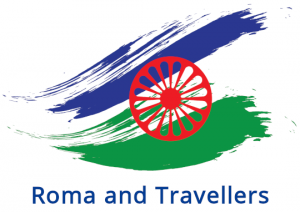Roma in Portugal
 The Roma in Portugal, known in spoken Portuguese as ciganos, are a minority ethnic group. Exact numbers in the country are unknown—estimates vary from 30,000 to 50,000.
The Roma in Portugal, known in spoken Portuguese as ciganos, are a minority ethnic group. Exact numbers in the country are unknown—estimates vary from 30,000 to 50,000.
As implied by some of their most common local names, the native Portuguese Roma belong to the Iberian Kale (Kalos) group, like most of the fellow Lusophone Brazilian ciganos, and the Spanish Romani people, known as gitanos, that share their same ethnic group. Their presence in the country in and around Minho goes back to the second half of the 15th century when they crossed the border from neighbouring Spain. Early on, due to their sociocultural differences and nomadic lifestyle, the ciganos were the object of fierce discrimination and persecution.
The number of Roma in Portugal is difficult to estimate, since it is forbidden to collect statistics about race or ethnic categories in the country. According to data from Council of Europe‘s European Commission against Racism and Intolerance there are about 40,000 to 50,000 spread all over the country. According to the Portuguese branch of Amnesty International, there are about 30,000 to 50,000. The national High Commissioner for Migrations places the number at around 37,000.
History
Portuguese Education System
Stages of the education system
Compulsory education lasts 12 years, between the age of six and 18 or until the conclusion of upper secondary education.
The Portuguese education system is divided in pre-school education (from the age of three until the start of basic education), basic education (6 to 15 years old) and upper secondary education (15 to 18 years old).
Pre-school education
Pre-school education covers children from three years old up to the age of compulsory schooling (six years old). Attending pre-school education is optional.
Basic education
- the first cycle corresponds to the first four years of schooling (grades one to four).
- the second cycle corresponds to the next two years (grades five and six).
- the third cycle lasts for three years and corresponds to lower secondary education (grades seven to nine).
Roma in Italy, Roma in Reggio Calabria
THE CONDITION OF ROMA, SINTI AND CAMINANTI COMMUNITIES IN ITALY
The Roma, Sinti and Caminanti (RSC) communities in Italy are characterized by the heterogeneity of the groups, by their linguistic-dialectal variety, as well as by different cultures. The various attempts over the years to promote integration, inclusion and their recognition as a minority (national or linguistic), confirm the complexity of the condition of Roma, Sinti and Caminanti. This status quo can be well understood, if we take into account the fact that when we talk about RSC communities, we are referring to: Italian citizens; foreign citizens belonging to other EU countries; foreigners, citizens of non-European countries; foreigners, who have been granted the right to asylum or subsidiary protection; (de facto) stateless people, born in Italy from de facto stateless people In particular, it should be borne in mind that, at present, the minority of RSC is not concentrated in a specific area of the national territory, but rather spread throughout the country. (περισσότερα…)
Italian educational system
Stages of the education system
The Italian education and training system includes ECEC (0-3 and 3-6), primary, secondary, post- secondary and higher education.
Early childhood education and care (ECEC)
ECEC for children aged less than 3 years is offered by educational services (servizi educativi per l’infanzia) ECEC for children aged from 3 to 6 years is available at preprimary schools (scuole dell’infanzia).
The two offers make up a single ECEC [12] system, called ‘integrated system’, which is part of the education system and is not compulsory. Although being part of the same system, the ECEC 0-3 is organised by the Regions according to the single regional legislations, while the 3-6 offer is under the responsibility of the Ministry of education.
Compulsory education
ROMA IN HUNGARY
 We do not know exactly when Roma arrived in Hungary. In recent decades the historical literature has identified the earliest source relating to Roma as a document dating from 1416. The document indicates that Roma were already present in Transylvania around 1400. Roma arrived in the Balkan countries in the mid-14th century, moving on to Wallachia, where they are first mentioned in 1385. From Wallachia they migrated to Transylvania. In later centuries too, Roma came from the Romanian principalities to Transylvania and Hungary. Sporadic references to persons named Cigan, Cygan or Chygan or to villages named Zygan can be found in charters from the 13th–14th centuries. In the late 15th century and early 16th century, strengthening fortifications and manufacturing weapons were not the only forms of employment practiced by Roma, for some of them were musicians. By the late 16th century or the early 17th century, Roma had nevertheless reached all parts of Hungary.
We do not know exactly when Roma arrived in Hungary. In recent decades the historical literature has identified the earliest source relating to Roma as a document dating from 1416. The document indicates that Roma were already present in Transylvania around 1400. Roma arrived in the Balkan countries in the mid-14th century, moving on to Wallachia, where they are first mentioned in 1385. From Wallachia they migrated to Transylvania. In later centuries too, Roma came from the Romanian principalities to Transylvania and Hungary. Sporadic references to persons named Cigan, Cygan or Chygan or to villages named Zygan can be found in charters from the 13th–14th centuries. In the late 15th century and early 16th century, strengthening fortifications and manufacturing weapons were not the only forms of employment practiced by Roma, for some of them were musicians. By the late 16th century or the early 17th century, Roma had nevertheless reached all parts of Hungary.
Immigration
Roma immigration started in 16th century and continued throughout 17th centuries and became even more significant in the 18th and 19th centuries. The Roma immigrants were Romani native speakers; they learnt Hungarian after their arrival in the country. Within several generations, their linguistic assimilation was complete and they no longer spoke Romani. Some smaller groups, however, preserved their knowledge of the language. In some counties some Roma continue to speak Romani (the Carpathian dialect) as well as Hungarian. (περισσότερα…)
HUNGARIAN EDUCATION SYSTEM
In Hungary, schools and kindergartens are established and maintained by the state, local governments, minority local governments, legal entities (foundations, churches, etc.) as well as natural persons. About 90 per cent of children attend public sector institutions.
The maintenance of the education system became more centralized. In January 2013, the state took over the maintenance of public education institutions (with the exception of kindergartens)from the local authorities. The Government established Klebelsberg Institution Maintenance Centre for the maintenance of these institutions. Local governments get contribution from the central budget to finance kindergarten education, they are responsible for the organisation of ECEC on their settlement. Minority governments are allowed to establish schools and teach in their own languages. (περισσότερα…)
Roma in Spain
 Currently, Spanish society is a mosaic of historical and cultural realities with their own peculiarities, languages and peoples. In this multicultural context, it is necessary to make known that the Roma reality in Spain has six centuries of history and is very diverse.
Currently, Spanish society is a mosaic of historical and cultural realities with their own peculiarities, languages and peoples. In this multicultural context, it is necessary to make known that the Roma reality in Spain has six centuries of history and is very diverse.
The Roma people have been assimilating many of the cultural elements that have been found in the different territories that they have crossed in their way from India and, thanks to this, the current common culture is full of their contributions made both in the language, as trade, music, literature and many other arts.
Roma people are fully right citizens, in Spain and in the European Union. They have cultural features that are their own and share a common identity, which does not detract anything from their citizenship, but rather on the contrary, it implies wealth and added value for the society of which we are all part. (περισσότερα…)
Spanish educational system
Spain educational system
Stages of the education system
Pre-primary education is up to 6 years of age. Although it is not a compulsory education stage, the second cycle is free in all publicly-funded schools (public schools and publicly-funded private schools). Public schools providing it are called pre-primary schools and those also offering primary education are called pre-primary and primary schools.
Basic education is compulsory and free in publicly-funded schools. It lasts ten years and it is divided into two stages:
- Primary education, provided in primary schools. It covers six academic years, usually studied between the ages of 6 and 12
- Compulsory secondary education, studied in secondary schools, between the ages of 12 and 16. At the end of this stage, students receive the first official certificate, the Lower Compulsory Secondary Education Certificate, which allows them to have access to upper secondary education or the world of work.
The Roma Of Greece – Roma in Rhodes
The Roma Of Greece
The Roma Of Greece, settled or displaced, are part of the Roma living in almost all parts of the world. They first appeared around the 11th century in areas of the Byzantine Empire and somewhere between the 14th and 15thcentury in today’s Greek area. Since then they have lived in various parts of Greece, from Crete to Thrace, and according to their particular perceptions and social structure have been organised in temporary or permanent settlements. They depend their economic activities on market needs presented to the surrounding society.
After the First World War, and particularly after the Asia Minor Disaster, a second large Roma migratory stream entered Greece from the Constantinople and Izmir area (Ioannidou 1990:436). Some Roma groups who have apparently moved from Romania and Albania, as early of the 20th century to just as recently, use many elements of the Romanian and Albanian language. (περισσότερα…)
Greek education
Greek educational system
Stages of the education system
Compulsory education lasts 11 years and extends from the ages of 4 to 15. The stages of the Greek education are mainly 3:
1) Primary education
Primary education includes pre-primary and primary schools.
Nipiagogeio
Nipiagogeio (pre-primary school) in Greece has become compulsory for all 4-year-old children, since school year 2018/19. School year 2020/21 foresees the integration of the two-year compulsory pre-primary school in the few remaining municipalities.
Infant centres (vrefikoi stathmoi), infant/child centres (vrefonipiakoi stathmoi) and child centres (paidikoi stathmoi) represent early childhood care. They are run under the remit of the municipal authorities. They cater for children between the ages of 2 months and up to the age of the beginning of compulsory education.
Dimotiko scholeio (περισσότερα…)







